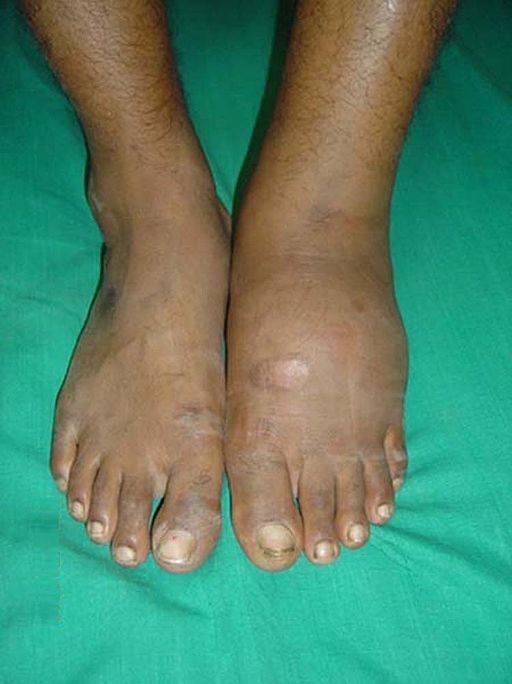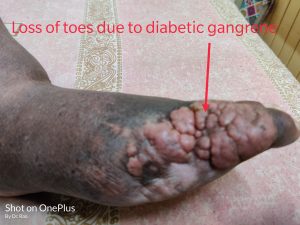DIABETIC FOOT DISEASE
What is diabetic foot disease?
Diabetic foot disease is a complication of poorly controlled diabetes. The picture below shows various presentations of how the changes take place in the foot due to poorly controlled blood sugar in diabetes.
Introduction
On 11th August 2020, I published an article on complications of diabetes.

You can read about these complications by visiting the article cited below-
After this article, Diabetic Retinopathy article came up. Following it up, I have published this one, which is also important because the mismanagement of this condition can lead to amputation/loss of lower limbs/ toes/ foot.
Diabetic foot disease is one of the most common complications of diabetes. It occurs when high blood sugar damages small blood vessels in the feet and makes them less able to heal after an injury.
Left untreated, these wounds can get bigger and become infected, eventually leading to amputation in 25-50% of patients. Neglecting your diabetic foot care can lead to serious consequences, but it’s not inevitable if you know what to look out for and how to prevent further damage.
It’s important to understand the risks of leaving your feet unchecked as well as the preventative measures that you can take as a precaution.
Different complications of Diabetes—a snapshot
In my day-to-day practice, I come across many patients with various ailments. Diabetes is one such ailment that has different signs and symptoms. Diabetes also has many complications [see below for a snapshot of the same].

About this article
Over a period of time, I have noticed that educating the patient having diabetes plays a significant role in preventing these complications.
Diabetes affects nearly 30 million Americans, and many people with diabetes also suffer from diabetic foot disease. This condition occurs when there is an infection in the skin that leads to ulcers and other problems.
Out of the many complications, diabetic foot disease is quite common. I have mentioned a few in the picture above. Diabetes foot disease comes under two categories-
- Peripheral Vascular disease
- Peripheral Neuropathy.
Sometimes both occur together. So, whenever a patient visits me for diabetes treatment, I make it a point to rule out these complications.
Importance of learning about diabetic foot disease
We all have two feet. Feet are those parts of our body on which we stand/walk/and run. These small parts of our lower limbs bear the maximum body weight and hence, they are prone to maximum wear and tear and injuries in the form of sprain, fractures of bones, and ulceration due to infection.
In a diabetic person, they appear as complications or foot problems. Diabetics often develop sores on their feet because they don’t feel pain as easily as others do. These sores can lead to serious infections if not treated properly.
What are we going to learn here
Diabetic foot disease is a vast topic. For the sake of simplicity and better understanding, I am going to split this article into two parts-
- Causes, risk factors, and various stages based on its appearance/presentation.
- Care of the foot includes prevention of ulcer in the first place, treatment of the causative factors, and finally, treatment of the ulcer if it has already formed.
In this article, we shall learn and understand the various aspects of the disease. In the next one, we will learn how to prevent it as well as how to treat it. This includes taking care of your foot/feet on a daily basis.
How does a patient of Diabetic patient present?
Based on what stage the patient visits my clinic for treatment, I have noted that a diabetic foot can present as-
- A thickening of the skin on the sole of the foot due to frequent friction or rubbing- medically termed callus formation.
- Loss of sensation or tingling numbness in the sole due to nerve supply impairment- medically termed diabetic neuropathy.
- Deformation of the foot due to weakening of blood supply to the bone causing loss of bone density and subsequently leading to fractures, dislocation of the joints, and shape of the foot-medically termed diabetic arthropathy. This is also known as Charcot arthropathy.
- Longstanding diabetes causes changes in blood vessels supplying blood to the foot, medically termed angiopathy. There is impairment of blood supply leading to-
- Swelling,
- ulcer formation
- and Gangrene of the foot.
In fact, all the above-mentioned conditions collectively cause this last complication.
Diabetic foot presentations-
As you can see below, diabetic foot disease can present in many ways.

So, let’s get on with understanding the first part i.e. causes, risk factors, and various stages.
4 Symptoms of Diabetic Foot Disease
Here’s how to spot them.
If you notice any of these symptoms, see your doctor right away. You should also check your feet daily, especially after walking or exercising.
- Blisters or Sores on Feet.
- Blisters and sores on the bottom of your feet are common among diabetics. They usually appear when there’s an injury to the skin, such as a cut or scrape.
- Painful Skin– the skin of the foot hurts, even on slight touch. This is due to the damage caused by high blood sugar to the nerves supplying the skin. As the disease progresses, this painful condition may turn into loss of sensation and a feeling of numbness sets in.
- Redness– the skin of the foot can appear red due to inflammation. As the disease progresses, there can be swelling due to accumulation of fluid, also called edema of the foot.
- If you notice any redness, swelling, or pus coming out of your foot, see your doctor right away.
- You should also keep track of how much fluid comes out of your wound. This will help your doctor determine whether you need antibiotics.
- If left alone without treatment, this can progress to wet gangrene which can lead to amputation of the foot.
- Swelling- Poor circulation of blood by the arteries and veins causes accumulation of fluids. This can also be due to diabetic kidney failure.
Diabetes is one of the leading causes of amputation in the United States. In fact, more than half of people with diabetes lose some part of their foot due to complications. If you notice any of these symptoms, see your doctor immediately. You should also make sure to keep your feet clean and dry at all times.
Why Knowing About This Condition Important?
Diabetic foot disease is the most important cause of lower extremity[limb] amputation{LEA} after direct injuries like an accident. About 85% of the total amputations of the leg/legs occur due to this disease alone. Moreover, diabetics are more prone to developing ulcers on their foot/feet.
According to research statistics, about 15% of these patients develop ulcers[ wounds] and the risk of LEA increases 8 folds once ulceration has occurred.
Diabetic foot causes
Diabetic foot is caused by the following factors-
- Poorly controlled blood sugar
- Loss of sensation in different parts of the foot due to nerves getting affected by high blood sugar- a condition called Diabetic Neuropathy
- Poor blood supply to various parts of the foot is termed Diabetic Angiopathy. Angiopathy is inflammation of blood vessels causing narrowing of arteries. They can happen in both large [macroangiopathy] as well as small [microangiopathy] vessels. A total lack of blood supply then leads to the death of tissues of the foot and ultimately causes ulceration and gangrene.
- Change in the structure of the foot leading to deformity termed Arthropathy [as shown below-Charcot Arthropathy]
- A combination of Neuropathy and Arthropathy collectively termed Neuroarthropathy
- Autonomic Neuropathy– a condition where the sweat glands get affected leading to poor or no sweating and causing cracks or fissures in the sole of the foot. This, combined with poor sensation, deformation of the foot joint, particularly the ankle, and poor blood supply can lead to infection of the cracks/fissures and ultimately wounds that do not heal fast.
Charcot foot deformity
This is a picture showing the deformation of the left foot caused due to loss of sensation and repeated injuries like the sprain of the ankle joint. This is called Charcot Foot and is very common in Diabetic Foot Disease.

Let’s learn the signs and symptoms of a patient of Diabetic foot disease by looking up at one of the cases that came to me for treatment-
Case study-

A few years ago, one patient under my treatment for diabetes presented with –
- Loss of sensation in both feet
- Tingling and numbness in toes
- Unable to feel the floor while walking- he felt as if he was walking on air.
On examination, I found these signs-
- There was no response to pinpricks.
- The left great toe was veering towards the second toe- a condition called hallux valgus.
- A small painless callus had formed on the sole just below the starting point of the great toe.
- Absence of pulsation of the Dorsalis Pedis artery- the one that supplies blood to the foot.
- I checked his blood sugar on my Accu-Chek glucometer. His random blood sugar was above 300 mg/dl.
I then ordered these tests to confirm my diagnosis of diabetic foot disease-
- HbA1C
- Color Doppler study of arteries of the left lower leg and foot
- X-ray of left foot to rule out arthropathy.
Findings from the tests-
The patient’s –
- HbA1C was very high-12.
- His color doppler study showed that the arteries to the foot were blocked suggesting macroangiopathy.
- An X-ray of the left foot showed the bones were also getting affected and the arch of the foot was losing its curvature and turning into a flat foot.
This patient was referred to hospital for amputation of his toes and to bring his blood sugar under control.
Other Diabetic foot infections
- Athlete’s foot – the picture below shows fungal/ yeast infection affecting the foot of another diabetic patient.

- Onychomycosis–
Another way the foot can be affected is by fungal infections of the toenails. Shown below is the early stage of such infection of the great toenail. It is called Onychomycosis.

CONCLUSION
In this post, I have discussed what you should look out for in diabetic foot disease. In my next post, I will discuss various modes of treatment as well as preventive measures for this disease.
Hope you have found this article useful. Do share it with anyone you know suffering from diabetes- who knows, it may save their leg!
Disclosure-
This article contains affiliate links which pay commission to the author on purchase of items using these links, without any extra cost to the purchaser, including regular discounts/offers on purchase.

